
Net Promoter Score (NPS) continues to be relied upon heavily by consumer product/service companies for a good reason
Net Promoter Score (NPS) continues to be relied upon heavily by consumer product/service companies for a good reason, responding consumers are the ones making the final purchase decision. Understanding a customer’s perspective on his/her interaction with a product or service and their willingness to promote (or not promote) your offering to friends or family can be game changing in the fast-paced consumer world. Especially strong brands explore product quality and service and then enhance those qualities when positive, and correct them when feedback is negative.
Today, more and more B-to-B companies are including NPS in their research toolbox. It’s an easy question to ask, and a follow-up open-end question makes the results more insightful. The challenge these companies face appears during the interpretation of the results… what does it mean? Is the NPS rating an accurate indicator of future purchase behavior or loyalty? How does their score stack up against competitors? How do scores vary based on the strength of the relationship between the two companies? How do scores range based on the role of the individual and his/her interactions with the product/service provider?
1. Understand NPS scores may change based on customer point of interaction
Different from consumer decision making, B-to-B purchases often involve committees, groups, or informal ad-hoc teams of colleagues put together to look at all the information from various perspectives, narrow the consideration set, and make purchase recommendations. The final decision maker will then review the proposed solutions, make his/her decision and make or authorize the purchase. Depending on the number of touchpoints your customers have within your organization it may be necessary to explore NPS scores based on the point of interaction.
For example, thinking about the construction industry – one person selects/recommends a product for use on the project – perhaps the architect, engineer, or general contractor. One places the order, might be a distributor, general contractor or purchasing/procurement person. Another receives the request on the job site, think foreman, supervisor, or general contractor. While still another installs/uses the product (contractor, technician) and cleans up the job site. And, yet another may be responsible for servicing the product at some point in the future. Who’s NPS score carries the most weight and will be the best indicator of future loyalty? Should a relationship average be calculated? Should we segment scores using job function/responsibility?
2. Establish an NPS benchmark for your company and go from there.
We all like to know how we stack up to our competitors and there are many ways to measure our performance relative to the competition. However, NPS scores can vary widely from one organization to another based on how they are calculated and reported. Keep in mind when competitors are sharing their NPS, they are putting their best foot forward. The score has been estimated to be as positive as possible.
When measuring the performance of your company, create a benchmark and track your progress moving forward. Listen to the information shared in the open-end feedback question and adjust the customer experience as necessary. Conduct additional research to determine if feedback is situational (unique to that individual) or a common occurrence and source of frustration for many. Adjust your customer experience to be more positive, continue measuring NPS, and watch your scores improve.
3. Enhance your understanding of your NPS score by asking “Would you hire this person?”
If you have called Delta or Disney for any complaint or problem you will note that, for a few years now, they end each call with “stay on the line to complete a brief survey.” This brief survey contains one single NPS question of “Would you hire the last person you spoke with?” or “If you ran a customer service company, would you hire this individual?” This phrasing isolates the experience at a specific touchpoint and is perfectly suited for any employee that comes into contact with a customer, and empowers the customers to act as if s/he were the “CEO of a customer service company,” elevating their status and feeling of importance for a brief moment. This feedback can help you identify opportunities for improvement in the customer relationship.
4. Monitor social media for product related feedback but keep in mind that B-to-B professionals rarely make vendor recommendations on social media.
Cautious professionals understand and do not overshare their experiences as they may not be reflective of the total exposure or opinion of the organization. Looking at some of the top social media profiles on Twitter, Facebook, and LinkedIn we see that executives rarely discuss private, internal purchase specifying or purchasing decisions. The considerations regarding one vendor over another remain secret in internal discussions.
Industry professionals may share product-related feedback in closed group discussions when sharing experiences with product performance in unique situations. Thinking about the food and beverage industry – individuals involved with product development may choose to discuss how one ingredient has performed in different categories (dairy, prepared foods, beverage, baked goods, etc.) relative to other similar ingredients. Or a discussion may be had about ingredient quality, availability, or environmental considerations impacting the industry. These are elements you can use to help further understand your NPS score. However, it’s likely more beneficial to keep your focus on survey feedback, not social media monitoring, to understand what is indeed being said about your company’s brand and identify ways to improve.
5. Take negative NPS scores seriously, even if barriers to switching may delay action.
While a product or service can have incredible appeal to a purchaser, with an obvious path to eliminate an existing vendor that falls short of expectations, the cost of switching from a particular vendor may outweigh negative experiences. In fact, buyers cannot switch and leave many SaaS products due to exorbitant fees associated with making the switch. In some instances, we find that NPS may uncover a net detractor score, but in reality, the cost of switching to a competitor will prevent a customer from acting…short term. In these situations, companies need to understand reasons for detraction and work diligently to provide a better customer experience to minimize and hopefully eliminate the inevitable likelihood losing a customer. No one wants to work with a bully or feel trapped in a situation. People will move on to better things and leave negative relationships; while they determine the best way to make the switch the negative word of mouth can be more detrimental to an organizations success than the low NPS rating. Take a low score seriously, and take the appropriate steps to ensure a great customer experience at all touchpoints.
Your B-to-B Net Promoter Score is one input in understanding customer loyalty and future likelihood of recommendation. There are many sources of customer experience information available today, and all are worthy of consideration. The weight an organization assigns to each input will largely influence their overall success. Assess the various data you have access to – research or otherwise, determine which are most meaningful and provide real insight into ways to continually improve your organization, then identify what can realistically be achieved given available resources and get started evolving your customer product and service experience. Companies that are continuously listening and evolving will be the ones that succeed in the future.
Daily, customers provide us with the privilege of servicing their needs, without them our products and/or services are not necessary.
